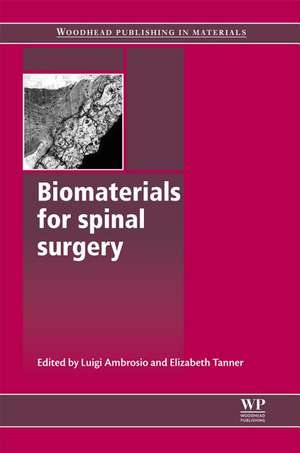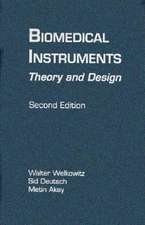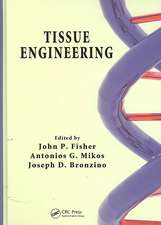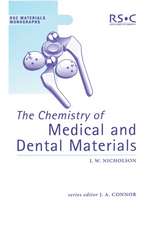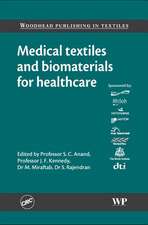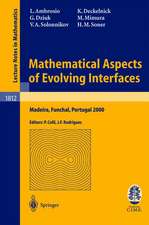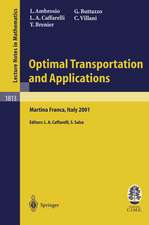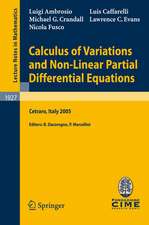Biomaterials for Spinal Surgery: Woodhead Publishing Series in Biomaterials
Editat de Luigi Ambrosio, Elizabeth Tanneren Limba Engleză Hardback – 11 mar 2012
After an introduction to the subject, part one reviews fundamental issues such as spinal conditions and their pathologies, spinal loads, modelling and osteobiologic agents in spinal surgery. Part two discusses the use of bone substitutes and artificial intervertebral discs whilst part three covers topics such as the use of injectable biomaterials like calcium phosphate for vertebroplasty and kyphoplasty as well as scoliosis implants. The final part of the book summarises developments in regenerative therapies such as the use of stem cells for intervertebral disc regeneration.
With its distinguished editors and international team of contributors, Biomaterials for spinal surgery is a standard reference for both those developing new biomaterials and therapies for spinal surgery and those using them in clinical practice.
- Summarises recent developments in materials and therapies for the treatment of spinal conditions and examines how it is being applied for the benefit of patients
- Reviews fundamental issues such as spinal conditions and their pathologies, spinal loads, modelling and osteobiologic agents in spinal surgery
- Discusses the use of bone substitutes and artificial intervertebral discs and covers topics such as the use of injectable biomaterials like calcium phosphate for vertebroplasty and kyphoplasty
Din seria Woodhead Publishing Series in Biomaterials
- 5%
 Preț: 1209.61 lei
Preț: 1209.61 lei - 9%
 Preț: 1288.81 lei
Preț: 1288.81 lei - 20%
 Preț: 1116.12 lei
Preț: 1116.12 lei - 36%
 Preț: 1030.16 lei
Preț: 1030.16 lei - 5%
 Preț: 1403.92 lei
Preț: 1403.92 lei - 26%
 Preț: 990.05 lei
Preț: 990.05 lei - 5%
 Preț: 1047.40 lei
Preț: 1047.40 lei - 5%
 Preț: 1097.68 lei
Preț: 1097.68 lei - 36%
 Preț: 847.30 lei
Preț: 847.30 lei - 9%
 Preț: 1159.07 lei
Preț: 1159.07 lei - 5%
 Preț: 1341.04 lei
Preț: 1341.04 lei - 5%
 Preț: 1116.94 lei
Preț: 1116.94 lei - 5%
 Preț: 1115.67 lei
Preț: 1115.67 lei - 20%
 Preț: 901.66 lei
Preț: 901.66 lei - 5%
 Preț: 1114.31 lei
Preț: 1114.31 lei - 26%
 Preț: 903.89 lei
Preț: 903.89 lei - 36%
 Preț: 939.94 lei
Preț: 939.94 lei - 5%
 Preț: 1511.70 lei
Preț: 1511.70 lei - 5%
 Preț: 1071.15 lei
Preț: 1071.15 lei - 9%
 Preț: 1090.57 lei
Preț: 1090.57 lei - 9%
 Preț: 1044.12 lei
Preț: 1044.12 lei - 29%
 Preț: 847.49 lei
Preț: 847.49 lei - 9%
 Preț: 1003.98 lei
Preț: 1003.98 lei - 5%
 Preț: 1050.99 lei
Preț: 1050.99 lei - 5%
 Preț: 1600.80 lei
Preț: 1600.80 lei - 5%
 Preț: 986.00 lei
Preț: 986.00 lei - 5%
 Preț: 1118.83 lei
Preț: 1118.83 lei - 5%
 Preț: 1050.99 lei
Preț: 1050.99 lei - 20%
 Preț: 1038.08 lei
Preț: 1038.08 lei - 5%
 Preț: 902.90 lei
Preț: 902.90 lei - 9%
 Preț: 1070.42 lei
Preț: 1070.42 lei - 5%
 Preț: 1512.75 lei
Preț: 1512.75 lei - 29%
 Preț: 1282.87 lei
Preț: 1282.87 lei - 25%
 Preț: 1121.07 lei
Preț: 1121.07 lei - 5%
 Preț: 1253.32 lei
Preț: 1253.32 lei - 9%
 Preț: 1204.85 lei
Preț: 1204.85 lei - 26%
 Preț: 1046.86 lei
Preț: 1046.86 lei - 5%
 Preț: 835.44 lei
Preț: 835.44 lei - 5%
 Preț: 838.79 lei
Preț: 838.79 lei - 5%
 Preț: 940.93 lei
Preț: 940.93 lei - 5%
 Preț: 940.63 lei
Preț: 940.63 lei - 5%
 Preț: 1115.22 lei
Preț: 1115.22 lei - 5%
 Preț: 989.25 lei
Preț: 989.25 lei - 20%
 Preț: 1598.75 lei
Preț: 1598.75 lei - 20%
 Preț: 964.40 lei
Preț: 964.40 lei - 20%
 Preț: 903.00 lei
Preț: 903.00 lei - 5%
 Preț: 1333.41 lei
Preț: 1333.41 lei
Preț: 1290.67 lei
Preț vechi: 1616.30 lei
-20% Nou
Puncte Express: 1936
Preț estimativ în valută:
246.96€ • 257.85$ • 204.40£
246.96€ • 257.85$ • 204.40£
Carte tipărită la comandă
Livrare economică 28 martie-11 aprilie
Preluare comenzi: 021 569.72.76
Specificații
ISBN-13: 9781845699864
ISBN-10: 1845699866
Pagini: 640
Dimensiuni: 156 x 234 x 47 mm
Greutate: 1.11 kg
Ediția:New.
Editura: ELSEVIER SCIENCE
Seria Woodhead Publishing Series in Biomaterials
ISBN-10: 1845699866
Pagini: 640
Dimensiuni: 156 x 234 x 47 mm
Greutate: 1.11 kg
Ediția:New.
Editura: ELSEVIER SCIENCE
Seria Woodhead Publishing Series in Biomaterials
Cuprins
Contributor contact details
Chapter 1: Introduction to biomaterials for spinal surgery
Abstract:
1.1 Introduction
1.2 Total disc replacement
1.3 Nucleus pulposus replacement
1.4 Materials for spinal applications
1.5 Conclusions
Part I: Fundamentals of biomaterials for spinal surgery
Chapter 2: An overview of the challenges of bringing a medical device for the spine to the market
Abstract:
2.1 Introduction
2.2 Selection and sourcing of materials in medical device developments
2.3 Biocompatibility testing
2.4 Medical device regulation
2.5 Conclusions
2.6 Acknowledgement
Chapter 3: Introduction to spinal pathologies and clinical problems of the spine
Abstract:
3.1 Introduction
3.2 Degenerative spine disease
3.3 Spinal trauma
3.4 Spinal deformity
3.5 Malignancy
3.6 Infection
3.7 Conclusions
Chapter 4: Forces on the spine
Abstract:
4.1 Introduction
4.2 In vivo measured components of spinal loads
4.3 In vitro measured spinal load components
4.4 Analytical models for spinal load estimation
4.5 Recommendations for the simulations of loads for in vitro and numerical studies
4.6 Conclusions
Chapter 5: Finite element modelling of the spine
Abstract:
5.1 Introduction
5.2 Functional spine biomechanics and strength of numerical explorations
5.3 Geometrical approximations in spine finite element modelling
5.4 Numerical approximations: accuracy and computational cost
5.5 Constitutive models for the spine tissues
5.6 Simulating the mechanical loads on the spine
5.7 Model verifications and interpretations: the validation concept and quantitative validation
5.8 Future trends and conclusions: the virtual physiological spine
Chapter 6: Osteobiologic agents in spine surgery
Abstract:
6.1 Introduction
6.2 Bone formation and healing
6.3 Osteobiologics for spine fusion
6.4 Bone growth factors
6.5 Cellular biologics
6.6 Conclusions
Part II: Spinal fusion and intervertebral discs
Chapter 7: Spine fusion: cages, plates and bone substitutes
Abstract:
7.1 Introduction
7.2 Spine fusion: historical concerns and surgical skills
7.3 Bone substitutes in spine fusion
7.4 Bone growth factors
7.5 Autologous bone marrow
7.6 Future trends
Chapter 8: Artificial intervertebral discs
Abstract:
8.1 Introduction
8.2 Structure and function of the intervertebral disc
8.3 The artificial intervertebral disc: design and materials
8.4 Fibre-reinforced composite materials: basic principles
8.5 Composite biomimetic artificial intervertebral discs
8.6 Future trends and conclusions
Chapter 9: Biological response to artificial discs
Abstract:
9.1 Introduction
9.2 The healing response to intervertebral disc implants
9.3 Infection as a cause of failure of implants
9.4 Loosening and the reaction to the products of wear and corrosion
9.5 Carcinogenicity and genotoxicity of metal implants
9.6 Conclusions
Part III: Vertebroplasty and scoliosis surgery
Chapter 10: The use of polymethyl methacrylate (PMMA) in neurosurgery
Abstract:
10.1 Introduction: a history of polymethyl methacrylate (PMMA)
10.2 Characteristics of polymethyl methacrylate (PMMA)
10.3 Preparation of polymethyl methacrylate (PMMA) for use in clinical practice
10.4 Clinical use of polymethyl methacrylate (PMMA) in neurosurgery
10.5 Developments in polymethyl methacrylate (PMMA)
10.6 Conclusions
Chapter 11: Optimising the properties of injectable materials for vertebroplasty and kyphoplasty
Abstract:
11.1 Introduction
11.2 Polymethyl methacrylate (PMMA) based bone cements
11.3 Calcium phosphate and calcium sulfate based bone cements
11.4 Conclusions
Chapter 12: Injectable calcium phosphates for vertebral augmentation
Abstract:
12.1 Introduction
12.2 Polymethyl methacrylate (PMMA)
12.3 Calcium phosphate cements
12.4 Conclusions
Chapter 13: Composite injectable materials for vertebroplasty
Abstract:
13.1 Introduction: a background on the use of composites in vertebroplasty
13.2 Properties of composites for vertebroplasty
13.3 Further development in composite injectable materials
13.4 Conclusions
Chapter 14: Scoliosis implants: surgical requirements
Abstract:
14.1 Introduction
14.2 Definition of scoliosis
14.3 Management of scoliosis
14.4 General principles for spinal fusion
14.5 Outcomes in scoliosis surgery
14.6 Future development of biomechanical implants
14.7 Conclusions
14.8 Sources of further information
Chapter 15: Shape memory, superelastic and low Young’s modulus alloys
Abstract:
15.1 Introduction
15.2 Fundamental characteristics of shape memory and superelastic alloys
15.3 Low Young’s modulus alloys
15.4 Metals required for spinal surgery
15.5 Conclusions
15.6 Acknowledgements
Part IV: Regenerative medicine in the spine
Chapter 16: Cell-based tissue engineering approaches for disc regeneration
Abstract:
16.1 Introduction
16.2 Rationale behind the use of cells
16.3 Choice of cell type (not including mesenchymal stem cells)
16.4 Current issues to be addressed
16.5 Future trends and conclusions
16.6 Sources of further information
Chapter 17: Angiogenesis control in spine regeneration
Abstract:
17.1 Introduction
17.2 The role and the mechanisms of angiogenesis
17.3 Physiological and pathological vascularisation of different intervertebral disc (IVD) histological compartments
17.4 Strategies to promote angiogenesis in tissue regeneration
17.5 Angiogenesis inhibition in intervertebral disc (IVD) regeneration and other clinical applications
17.6 Future trends
17.7 Sources of further information
17.8 Acknowledgements
Chapter 18: Stem cells for disc regeneration
Abstract:
18.1 Introduction
18.2 Tissue engineering solutions for intervertebral disc (IVD) disease
18.3 Mesenchymal stem cells (MSC) and regeneration of the intervertebral disc (IVD)
18.4 Regeneration of the annulus
18.5 Use of scaffolds with mesenchymal stem cells (MSC) for intervertebral disc (IVD) regeneration
18.6 Future trends
18.7 Conclusions
Chapter 19: Nucleus regeneration
Abstract:
19.1 Introduction
19.2 The intervertebral disc: anatomy, structure and function
19.3 Mechanics–biology interrelation
19.4 Annulus, nucleus and entire intervertebral disc: the tissue engineering approach
19.5 Conclusions
Chapter 20: In vivo models of regenerative medicine in the spine
Abstract:
20.1 Introduction
20.2 Selecting an animal model
20.3 Intervertebral spinal fusion
20.4 Degenerative disc disease
20.5 Future trends and conclusions
20.6 Acknowledgements
Index
Chapter 1: Introduction to biomaterials for spinal surgery
Abstract:
1.1 Introduction
1.2 Total disc replacement
1.3 Nucleus pulposus replacement
1.4 Materials for spinal applications
1.5 Conclusions
Part I: Fundamentals of biomaterials for spinal surgery
Chapter 2: An overview of the challenges of bringing a medical device for the spine to the market
Abstract:
2.1 Introduction
2.2 Selection and sourcing of materials in medical device developments
2.3 Biocompatibility testing
2.4 Medical device regulation
2.5 Conclusions
2.6 Acknowledgement
Chapter 3: Introduction to spinal pathologies and clinical problems of the spine
Abstract:
3.1 Introduction
3.2 Degenerative spine disease
3.3 Spinal trauma
3.4 Spinal deformity
3.5 Malignancy
3.6 Infection
3.7 Conclusions
Chapter 4: Forces on the spine
Abstract:
4.1 Introduction
4.2 In vivo measured components of spinal loads
4.3 In vitro measured spinal load components
4.4 Analytical models for spinal load estimation
4.5 Recommendations for the simulations of loads for in vitro and numerical studies
4.6 Conclusions
Chapter 5: Finite element modelling of the spine
Abstract:
5.1 Introduction
5.2 Functional spine biomechanics and strength of numerical explorations
5.3 Geometrical approximations in spine finite element modelling
5.4 Numerical approximations: accuracy and computational cost
5.5 Constitutive models for the spine tissues
5.6 Simulating the mechanical loads on the spine
5.7 Model verifications and interpretations: the validation concept and quantitative validation
5.8 Future trends and conclusions: the virtual physiological spine
Chapter 6: Osteobiologic agents in spine surgery
Abstract:
6.1 Introduction
6.2 Bone formation and healing
6.3 Osteobiologics for spine fusion
6.4 Bone growth factors
6.5 Cellular biologics
6.6 Conclusions
Part II: Spinal fusion and intervertebral discs
Chapter 7: Spine fusion: cages, plates and bone substitutes
Abstract:
7.1 Introduction
7.2 Spine fusion: historical concerns and surgical skills
7.3 Bone substitutes in spine fusion
7.4 Bone growth factors
7.5 Autologous bone marrow
7.6 Future trends
Chapter 8: Artificial intervertebral discs
Abstract:
8.1 Introduction
8.2 Structure and function of the intervertebral disc
8.3 The artificial intervertebral disc: design and materials
8.4 Fibre-reinforced composite materials: basic principles
8.5 Composite biomimetic artificial intervertebral discs
8.6 Future trends and conclusions
Chapter 9: Biological response to artificial discs
Abstract:
9.1 Introduction
9.2 The healing response to intervertebral disc implants
9.3 Infection as a cause of failure of implants
9.4 Loosening and the reaction to the products of wear and corrosion
9.5 Carcinogenicity and genotoxicity of metal implants
9.6 Conclusions
Part III: Vertebroplasty and scoliosis surgery
Chapter 10: The use of polymethyl methacrylate (PMMA) in neurosurgery
Abstract:
10.1 Introduction: a history of polymethyl methacrylate (PMMA)
10.2 Characteristics of polymethyl methacrylate (PMMA)
10.3 Preparation of polymethyl methacrylate (PMMA) for use in clinical practice
10.4 Clinical use of polymethyl methacrylate (PMMA) in neurosurgery
10.5 Developments in polymethyl methacrylate (PMMA)
10.6 Conclusions
Chapter 11: Optimising the properties of injectable materials for vertebroplasty and kyphoplasty
Abstract:
11.1 Introduction
11.2 Polymethyl methacrylate (PMMA) based bone cements
11.3 Calcium phosphate and calcium sulfate based bone cements
11.4 Conclusions
Chapter 12: Injectable calcium phosphates for vertebral augmentation
Abstract:
12.1 Introduction
12.2 Polymethyl methacrylate (PMMA)
12.3 Calcium phosphate cements
12.4 Conclusions
Chapter 13: Composite injectable materials for vertebroplasty
Abstract:
13.1 Introduction: a background on the use of composites in vertebroplasty
13.2 Properties of composites for vertebroplasty
13.3 Further development in composite injectable materials
13.4 Conclusions
Chapter 14: Scoliosis implants: surgical requirements
Abstract:
14.1 Introduction
14.2 Definition of scoliosis
14.3 Management of scoliosis
14.4 General principles for spinal fusion
14.5 Outcomes in scoliosis surgery
14.6 Future development of biomechanical implants
14.7 Conclusions
14.8 Sources of further information
Chapter 15: Shape memory, superelastic and low Young’s modulus alloys
Abstract:
15.1 Introduction
15.2 Fundamental characteristics of shape memory and superelastic alloys
15.3 Low Young’s modulus alloys
15.4 Metals required for spinal surgery
15.5 Conclusions
15.6 Acknowledgements
Part IV: Regenerative medicine in the spine
Chapter 16: Cell-based tissue engineering approaches for disc regeneration
Abstract:
16.1 Introduction
16.2 Rationale behind the use of cells
16.3 Choice of cell type (not including mesenchymal stem cells)
16.4 Current issues to be addressed
16.5 Future trends and conclusions
16.6 Sources of further information
Chapter 17: Angiogenesis control in spine regeneration
Abstract:
17.1 Introduction
17.2 The role and the mechanisms of angiogenesis
17.3 Physiological and pathological vascularisation of different intervertebral disc (IVD) histological compartments
17.4 Strategies to promote angiogenesis in tissue regeneration
17.5 Angiogenesis inhibition in intervertebral disc (IVD) regeneration and other clinical applications
17.6 Future trends
17.7 Sources of further information
17.8 Acknowledgements
Chapter 18: Stem cells for disc regeneration
Abstract:
18.1 Introduction
18.2 Tissue engineering solutions for intervertebral disc (IVD) disease
18.3 Mesenchymal stem cells (MSC) and regeneration of the intervertebral disc (IVD)
18.4 Regeneration of the annulus
18.5 Use of scaffolds with mesenchymal stem cells (MSC) for intervertebral disc (IVD) regeneration
18.6 Future trends
18.7 Conclusions
Chapter 19: Nucleus regeneration
Abstract:
19.1 Introduction
19.2 The intervertebral disc: anatomy, structure and function
19.3 Mechanics–biology interrelation
19.4 Annulus, nucleus and entire intervertebral disc: the tissue engineering approach
19.5 Conclusions
Chapter 20: In vivo models of regenerative medicine in the spine
Abstract:
20.1 Introduction
20.2 Selecting an animal model
20.3 Intervertebral spinal fusion
20.4 Degenerative disc disease
20.5 Future trends and conclusions
20.6 Acknowledgements
Index
Recenzii
"This is a good reference on biomaterials. It will be of most interest to materials engineers, bioengineers and spine surgeons. It is well written and provides an extensive list of references." --Doody's Book Reviews
